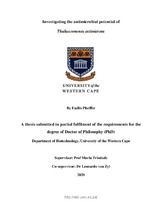| dc.contributor.advisor | Trindade, Marla | |
| dc.contributor.author | Pheiffer, Fazlin | |
| dc.date.accessioned | 2021-03-18T08:44:16Z | |
| dc.date.available | 2021-03-18T08:44:16Z | |
| dc.date.issued | 2020 | |
| dc.identifier.uri | http://hdl.handle.net/11394/7997 | |
| dc.description | Philosophiae Doctor - PhD | en_US |
| dc.description.abstract | bioassay guided isolation approach was then used to isolate the high molecular weight antibacterial compound (50kDa-100kDa) from T. actiniarum fermentations. With common protein isolation, purification and detection methods failing to provide insight into the nature of the antibacterial compound, we hypothesized that the active agent is not proteinaceous in nature and may be a high molecular weight exopolysaccharide. Extraction and antibacterial screening of the exopolysaccharide fraction from T. actiniarum showed antibacterial activity as well as lytic activity when subjected to a zymography assay using Pseudomonas putida whole cells as a substrate. Additionally, the biosynthetic pathways for the production of poly-β-1, 6-N-acetyl-glucosamine (PNAG), an exopolysaccharide involved in biofilm formation and chondroitin sulfate, a known and industrially important glycosaminoglycan with antibacterial and anti-inflammatory activity was identified and the mechanism may be novel. Genome mining identified a variety of novel secondary metabolite gene clusters which could potentially encode other novel bioactivities. Therefore a bioassay guided isolation, focused on the small (<3kDa) molecules, was pursued. Secondary metabolites were extracted, fractionated and screened for biofilm inhibition, antibacterial and anticancer activity and activity was observed in all assays. Active fractions were dereplicated by UHPLC-QToF-MS and compounds of interest were isolated using mass guided preparative HPLC. The purity of the isolated compounds was assessed using UHPLC-QToF-MS and NMR and the structure of the target compounds elucidated. Structures that could be determined were the bile acids cholic acid and 3-oxo cholic acid and although not responsible for the observed activities, this is the first report of bile acid production for this genus. This is the first study investigating the bioactive potential of the strain and the first demonstrating that T. actiniarum is a promising source of potentially novel pharmaceutically relevant natural products depicted through both culture-dependent and culture-independent approaches. | en_US |
| dc.language.iso | en | en_US |
| dc.publisher | University of the Western Cape | en_US |
| dc.subject | Bioactive natural products | en_US |
| dc.subject | Marine natural products | en_US |
| dc.subject | Heterologous expression | en_US |
| dc.subject | Genome mining | en_US |
| dc.subject | Exopolysaccharides | en_US |
| dc.subject | Bioassay-guided fractionation | en_US |
| dc.title | Investigating the antimicrobial potential of Thalassomonas actiniarum | en_US |
| dc.rights.holder | University of the Western Cape | en_US |

